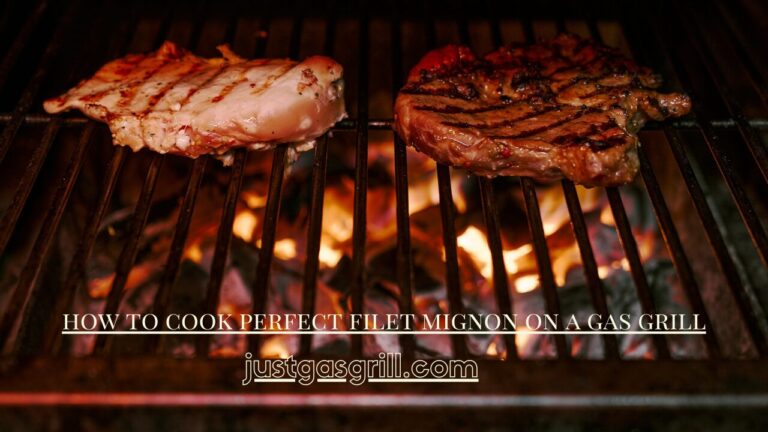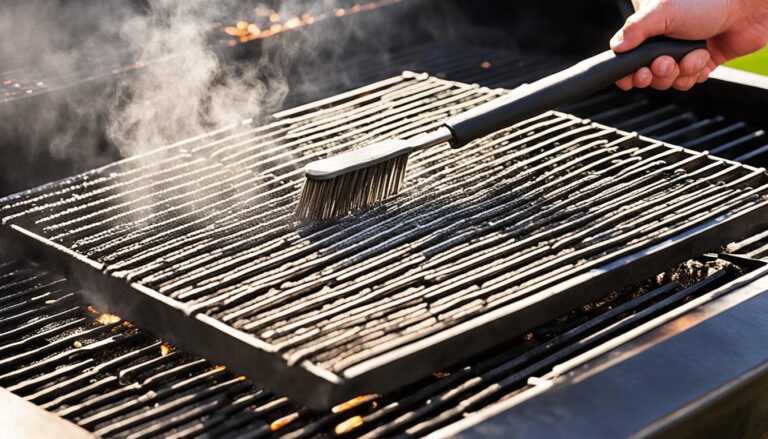
The sizzle of a steak on the grill brings back memories of summer and the smell of outdoor cooking. Standing by your grill, tongs in hand, you’re not just cooking a meal. You’re creating an experience. The perfect sear turns a simple steak into a work of art.
Grilling techniques have changed, but searing meat is still timeless. Whether you’re an expert or new to grilling, learning to sear is crucial. It takes your outdoor cooking to the next level. Let’s explore the art of flame-kissed flavors and how to get that perfect crust on your steak.
Searing is more than just making your steak look good. It’s a key step in creating flavor. When you sear a steak, you start the Maillard reaction. This process creates hundreds of new flavors. It’s what gives your steak that golden-brown crust and deep taste that makes you want to take a bite.
Key Takeaways
- Searing enhances flavor through the Maillard reaction
- Proper preparation is crucial for a perfect sear
- High heat is essential for achieving a good crust
- Timing and technique play vital roles in searing
- Rest your steak after searing for optimal juiciness
- Practice makes perfect when mastering grilling techniques
Understanding the Science of Searing
Grilling tips often focus on searing, a key step for delicious steaks. This process is fascinating and can improve your grilling skills.
The Maillard Reaction: Creating Flavor and Color
The Maillard reaction is vital for rich steak flavor. It happens when proteins and sugars in meat hit high heat, usually over 280°F. This creates new flavor compounds and the brown color we all enjoy.
Debunking the Moisture Seal Myth
Searing doesn’t seal in moisture, as many think. Instead, it makes the meat release water as proteins contract. The loud sizzle is the fast boiling of surface water into steam.
Why Searing Enhances Taste and Texture
Searing improves taste and texture through caramelization. It removes surface moisture, making flavors stronger and the steak look appetizing. For example, the afterburner method hits almost 800°F, giving steaks a perfect sear in 2 to 3 minutes per side.
| Searing Method | Temperature | Cooking Time |
|---|---|---|
| Afterburner | 800°F | 2-3 minutes per side |
| Vigneron | 800-1,000°F | Less than 10 minutes |
| Caveman | Variable | About 3 minutes total |
Knowing these principles can lead to better grilling results. It helps create the perfect mix of flavor, texture, and look for steaks.
Preparing Your Steak for the Grill
Choosing the right cut of meat is key to great grilling. Opt for high-quality cuts like ribeye, New York strip, or filet mignon. These cuts have lots of marbling, making them juicy and full of flavor.
Bringing Steak to Room Temperature
Take your steak out of the fridge 30 minutes before grilling. This is important for even cooking. Meat at room temperature cooks more evenly, giving you a better sear and doneness.
Patting Dry and Seasoning Techniques
Pat your steak dry with paper towels to remove extra moisture. This helps create a great crust when searing. Use kosher salt and freshly cracked black pepper for seasoning. Put it on generously to make a tasty crust.
For more complex flavors, try marinating steaks. A good marinade tenderizes the meat and adds depth to its taste. Marinate for 2-8 hours before grilling for the best results.
| Cut | Thickness | Searing Time (per side) |
|---|---|---|
| Ribeye/NY Strip | 1 inch | 3-4 minutes |
| Filet Mignon | 2 inches | 3-4 minutes, then indirect heat |
Thicker cuts (1.5 inches or more) work best. They get a perfect sear without overcooking the inside. With these tips, you’re ready for a memorable grilling experience.
Essential Equipment for Searing on the Grill
Searing steak on the grill needs the right gear. A top-notch grill with adjustable heat is key for that perfect crust. You also need sturdy grill grates for even heat and great grill marks.
Get long-handled tongs to flip your steak safely. An instant-read thermometer is a must for checking the meat’s temperature. For rare steaks, aim for 120-125°F, and 130-135°F for medium-rare.
- Charcoal grill: Offers intense heat and smoky flavor
- Gas grill: Provides precise temperature control
- Cast-iron skillet: Great for alternative searing methods
Remember safety first! A well-ventilated area is crucial. Keep a fire extinguisher handy and use heat-resistant gloves with hot tools.
| Steak Doneness | Temperature (°F) |
|---|---|
| Rare | 120-125 |
| Medium Rare | 130-135 |
| Medium | 140-145 |
| Medium Well | 150-155 |
| Well Done | 160-165 |
With these key grill grates and tools, you’re set to sear the perfect steak on your grill.
How to Sear Steak on Grill: Step-by-Step Guide
Learning to sear meat on the grill can take your cooking to the next level. This guide will help you get that perfect crust every time.
Preheating Your Grill to the Ideal Temperature
Begin by heating your grill to the best searing temperature. Aim for 450-500°F. This high heat is key for a great crust without overcooking the inside.
Positioning the Steak on the Grates
When your grill is hot, place your steak on the hottest grates. Direct heat is essential for proper searing.

Timing the Perfect Sear
The time to sear depends on the steak’s thickness. For a 1-inch steak, sear each side for 3-7 minutes. Thicker steaks, about 1 ¼ inches, need 8-10 minutes per side. Adjust these times as needed.
Flipping Techniques for Even Cooking
Flip your steak once or twice while searing. Use tongs to avoid piercing the meat and losing juices. This method ensures even cooking and keeps the steak’s internal temperature right.
| Doneness | Internal Temperature | Grill Time (per side) |
|---|---|---|
| Rare | 120-130°F | 3-4 minutes |
| Medium Rare | 130-135°F | 4-5 minutes |
| Medium | 135-140°F | 5-6 minutes |
After searing, let your steak rest for 5-10 minutes. This lets the juices spread, making the steak more flavorful and tender.
Mastering Grill Temperature Control
Learning how to control the grill temperature is crucial for a perfect steak sear. To cook outdoors successfully, you must know how to manage the heat on your grill. Set up two zones: a high heat for searing and a lower heat for finishing thicker cuts.
For gas grills, adjust the burners to make these zones. With charcoal grills, arrange the coals for direct and indirect heat. Use thermometers, either built-in or external, to keep an eye on the grill temperature while cooking.
The best grill temperature for searing steaks is between 450°F and 550°F. Cooking at lower temperatures won’t create the Maillard reaction, leaving your meat less flavorful.
| Doneness | Internal Temperature | Grilling Time (per side) |
|---|---|---|
| Rare | 120-125°F | 3-4 minutes |
| Medium Rare | 130-135°F | 4-5 minutes |
| Medium | 140-145°F | 5-7 minutes |
| Well Done | 160-165°F | 8-10 minutes |
These tips are for 1-inch thick steaks. Adjust the cooking time for thicker cuts. Always use a meat thermometer to check the internal temperature for the right doneness. With practice, you’ll get better at controlling the grill temperature and improve your outdoor cooking.
The Art of Seasoning: Enhancing Flavor Before Searing
Learning how to season steaks is key to making a delicious grilled dish. The right seasoning can take your steak from just okay to amazing.
Dry Rubs vs. Marinades
Dry rubs and marinades both have their perks for steak. Dry rubs add a tasty crust, while marinades make the meat tender and flavorful. For a quick flavor boost, mix salt, pepper, garlic powder, and paprika. When marinating, use olive oil, herbs, and a splash of vinegar or citrus juice.

Salt Timing: When to Season for Optimal Results
There’s a debate on when to add salt to steak. Some chefs, like Tom Colicchio and Jean François Bruel, say to season right before cooking. Others, like David Tanis and Judy Rodgers, suggest salting ahead of time. An experiment showed different results:
- Roast chicken seasoned a day before tasted better
- Dry-aged rib eyes got mixed reviews
- Pork racks salted before roasting stayed moister
- Braised lamb shanks seasoned ahead had deeper flavor
Experimenting with Herbs and Spices
Try new herbs and spices to boost your steak’s flavor. Use rosemary, thyme, or crushed peppercorns for a classic taste. For something bolder, try a Texas-style rub. The secret is finding the right balance so the meat’s natural taste shines through.
“The right seasoning can transform a good steak into an unforgettable dining experience.”
These tips will help you make steakhouse-quality meals at home. Whether you like dry rubs or marinating, getting the seasoning right will improve your grilling skills.
Advanced Searing Techniques for Grill Masters
Grill masters looking to improve their outdoor cooking can try advanced searing techniques. These methods help ensure perfectly seared meat every time. They take grilling to a new level.
The reverse sear method is a popular choice. It involves cooking your steak in a low oven until it hits 100°F inside. Then, finish it with a high-heat sear on the grill for a perfect crust.
Another technique is pan-searing on the grill with a cast-iron skillet. This method spreads heat evenly and creates a great crust. For extra flavor, add herbs, garlic, or butter to the pan while searing.
For medium-rare perfection, aim for an internal temperature of 130-135°F. Use a two-zone grill setup with the indirect zone at 225-250°F. After searing, let your steak rest for 10 minutes before slicing to keep the juices in.
| Doneness | Internal Temperature | Searing Time (per side) |
|---|---|---|
| Rare | 125°F | 2-3 minutes |
| Medium-Rare | 135°F | 2-3 minutes |
| Medium | 145°F | 2-3 minutes |
| Medium-Well | 155°F | 2-3 minutes |
Try different cuts like ribeye, filet mignon, or porterhouse to improve your searing skills. Each cut has its own flavors and textures. This lets you show off your grilling expertise.
Determining Steak Doneness: Visual and Temperature Cues
Mastering steak doneness is key to grilling the perfect cut. By using visual cues and temperature readings, you can achieve your desired level of doneness every time. Let’s explore some effective grilling tips to help you become a steak expert.
Using a Meat Thermometer Effectively
A reliable meat thermometer is your best friend when it comes to checking steak doneness. Insert it into the thickest part of the steak, avoiding fat or bone. For a medium-rare steak, aim for 130°F (54°C), while medium should reach 140°F (60°C). Remember, the internal temperature will rise slightly during resting, so it’s best to remove the steak from the grill when it’s about 5°F below your target temperature.
The Touch Test Method
If you don’t have a thermometer handy, the touch test can be a useful tool. Press the center of the steak with your finger. A rare steak will feel soft and spongy, medium-rare will have some resistance, and well-done will feel firm. This method takes practice, but it’s a valuable skill for any grill master to develop.
Resting Your Steak After Searing
After grilling, let your steak rest for 2-3 minutes. This allows the juices to redistribute throughout the meat, resulting in a juicier, more flavorful steak. During this time, carryover cooking will cause the internal temperature to rise by 3-6°F, so factor this into your cooking calculations. With these grilling tips and a good meat thermometer, you’ll be serving perfectly cooked steaks in no time.






